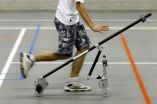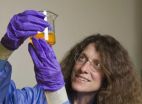(Press-News.org) Given sufficient forward speed, a bicycle pushed sideways, will not fall over. Scientists have been trying to find a conclusive explanation for this remarkable characteristic for over a century. This week, researchers at Delft University of Technology (TU Delft, The Netherlands) have thrown new light on the question in a publication in Science.
Staying stable
The research at TU Delft, in collaboration with scientists from Cornell University (USA), centred on the following intriguing question: why is a bicycle self stable, above a certain speed? You add speed to a bike and can then give it a sideways push without it falling over.
Rotating wheels
Scientists have long been poring over this complicated question, even from as far back as the nineteenth century. Until recently, the consensus within the scientific community was that the stability was very closely related to two factors. First, the rotating wheels of the bicycle were supposed to provide stability through gyroscopic effects. Secondly, it was thought that the 'trail' played an important part. Trail is the distance by which the contact point of the front wheel trails behind the steering axis.
Predicting
The publication by TU Delft in Science puts paid to this old notion once and for all. 'We have known for years that the generally accepted explanation for the stability of the bicycle was too simple,' says researcher Dr Arend Schwab of the 3mE faculty at TU Delft. 'Gyroscopic effects and trail do help, but are not essential for stability.' Dr Schwab and a number of colleagues brought out a publication several years ago on the theory behind the stability of the bicycle (in 2007 in Proceedings of the Royal Society, doi:10.1098/rspa.2007.1857). A mathematical model with around 25 physical parameters was developed at the time, which appeared to be able to predict very accurately whether, and at what speeds, a particular design of bicycle would be stable.
Experiment
'In our publication in Science we have now shown not only theoretically but also by means of experiment that our insights are correct.' Together with PhD student Jodi Kooijman, Schwab designed and constructed a bicycle with which it could be shown, in an experiment, that both gyroscopic effects and trail are not necessary for a bicycle to remain stable by itself above a certain speed.
This is the so-called Two Mass Skate bicycle. It has small and counter rotating wheels, which means there is no gyroscopic effect to speak of, and a small negative trail (in other words, where the point of contact of the front wheel is marginally in front of the steering axis). And yet the bicycle remains stable.
Giving up
'It was not easy,' explains PhD student Jodi Kooijman, who carried out most of the experimental work. 'The first prototype did not work, and we had almost given up hope after a number of iteration attempts, when we suddenly found ourselves able to show the stability. But of course everything has to fall into place. You have to deal with the ground surface, for example, which has to have exactly the right roughness and stiffness. In Sporthal II of TU Delft we found all the right conditions.'
Steering
So the theory has now been proven by experiment. But has the experimental work led to the emergence of new theoretical insights? Dr Schwab answers, 'We have demonstrated that the mass distribution is also important for stability, especially the location of the centre of mass of the bicycle's steering mechanism.' For a bicycle to be stable, the steering mechanism has to be unstable; if the bike falls, the steering should fall even more quickly.
Bicycle manufacturers
Are the theoretical insights of Schwab and his companions of any use to bicycle manufacturers? 'Certainly. Today's bicycles are the result of a fairly long evolutionary process, and are therefore rather conservative. Essentially, there is nothing about the basic design of the bicycle that has changed since the end of the nineteenth century. Manufacturers can use our model to make directed modifications to the stability of their bicycles. That may be of particular interest for unusual designs, such as recumbent bicycles, folding bicycles and cargo bicycles.'
INFORMATION:
More information
Title: A Bicycle Can Be Self-Stable Without Gyroscopic or Caster Effects.
Authors: J.D.G. Kooijman; A. L. Schwab (TU Delft), J.P. Meijaard (University of Twente), J.M. Papadopoulos (University of Wisconsin–Stout), A. Ruina (Cornell University)
Website Science publication, with extensive background material, photos and video:
http://bicycle.tudelft.nl/stablebicycle/
Website Bicycle Dynamics research, for more information on the background of this research:
http://bicycle.tudelft.nl/schwab/Bicycle/index.htm
Why does a moving bicycle not fall over? TU Delft casts aside some old theories
2011-04-15
ELSE PRESS RELEASES FROM THIS DATE:
Highest percentage of Americans in 4 decades say financial situation has gotten worse
2011-04-15
A recently released report of the General Social Survey, conducted by NORC at the University of Chicago, shows that for the first time since 1972, more Americans say that their financial situation has gotten worse in recent years rather than better. Understandably, also for the first time since 1972, the percentage of Americans saying that they are "not at all" satisfied with their financial situation (31.5%) notably exceeds those saying they are "pretty well" satisfied (23.4%).
The General Social Survey which NORC has conducted for forty years, is supported by the National ...
People who overuse credit believe products have unrealistic properties
2011-04-15
COLUMBIA, Mo. – A University of Missouri researcher says people who overuse credit have very different beliefs about products than people who spend within their means. Following a new study, Marsha Richins, Myron Watkins Distinguished Professor of Marketing in the Trulaske College of Business, says many people buy products thinking that the items will make them happier and transform their lives.
"There is nothing wrong with wanting to buy products," Richins said. "It becomes a problem when people expect unreasonable degrees of change in their lives from their purchases. ...
TBI Therapy and Nutrition: IOM report releases April 20
2011-04-15
Nutrition research is pointing to ways that nutrients or diets may lessen the effects of traumatic brain injury (TBI), raising the possibility that the U.S. Department of Defense might be able to use nutritional approaches to help personnel who receive a TBI. Nutrition and Traumatic Brain Injury: Improving Acute and Subacute Health Outcomes in Military Personnel, a new report from the Institute of Medicine, recommends which nutritional approaches DOD should adopt and priorities for further research into nutrients and diets that show promise for being effective in providing ...
Targeting top 911 callers can trim cost, improve patient care
2011-04-15
Repeated unnecessary 911 calls are a common drain on the manpower and finances of emergency medical services, but a pilot program that identified Baltimore City's top 911 callers and coupled them with a case worker has succeeded in drastically cutting the number of such calls while helping callers get proper care.
The program, called Operation Care, was conceived and implemented by the non-profit agency Baltimore HealthCare Access and ran as a three-month pilot in 2008. Now, a newly published report of its results appearing in The American Journal of Emergency Medicine ...
Studies of marine animals aim to help prevent rejection of transplanted organs
2011-04-15
(Santa Barbara, Calif.) –– Studies of the small sea squirt may ultimately help solve the problem of rejection of organ and bone marrow transplants in humans, according to scientists at UC Santa Barbara.
An average of 20 registered patients die every day waiting for transplants, due to the shortage of matching donor organs. More than 110,000 people are currently waiting for organ transplants in the U.S. alone. Currently, only one in 20,000 donors are a match for a patient waiting for a transplant.
These grim statistics drive scientists like Anthony W. De Tomaso, assistant ...
Older workers benefit from high-tech, high-touch health promotion
2011-04-15
Older workers benefit most from a modest health behavior program when it combines a web-based risk assessment with personal coaching.
University of Illinois at Chicago researchers conducted a randomized trial to evaluate two worksite wellness interventions assessing older workers' health behaviors and outcomes. The findings are available online and will be published in an upcoming issue of the American Journal of Public Health.
The health behaviors that were examined were physical activity, diet, stress reduction and smoking cessation, says Susan Hughes, professor of ...
Novel therapy improves immune function in teen with rare disease
2011-04-15
In a novel approach that works around the gene defect in Wiskott-Aldrich syndrome, an inherited immune deficiency disorder, researchers used an alternative cell signaling pathway to significantly improve immune function in a 13-year-old boy with the disease. The study, at The Children's Hospital of Philadelphia, provides a proof-of-principle that immunotherapy, which harnesses elements of the body's immune system, may be used to treat this rare but often deadly disorder.
"If this encouraging initial result holds up in further ...
Inability to detect sarcasm, lies may be early sign of dementia, UCSF study shows
2011-04-15
By asking a group of older adults to analyze videos of other people conversing -- some talking truthfully, some insincerely -- a group of scientists at the University of California, San Francisco has determined which areas of the brain govern a person's ability to detect sarcasm and lies.
Some of the adults in the group were healthy, but many of the test subjects had neurodegenerative diseases that cause certain parts of the brain to deteriorate. The UCSF team mapped their brains using magnetic resonance imaging, MRI, which showed associations between the deteriorations ...
Recipe for radioactive compounds aids nuclear waste and fuel storage pools studies
2011-04-15
ALBUQUERQUE, N.M. — Easy-to-follow recipes for radioactive compounds like those found in nuclear fuel storage pools, liquid waste containment areas and other contaminated aqueous environments have been developed by researchers at Sandia National Laboratories.
"The need to understand the chemistry of these compounds has never been more urgent, and these recipes facilitate their study," principal investigator May Nyman said of her group's success in encouraging significant amounts of relevant compounds to self-assemble.
The trick to the recipes is choosing the right templates. ...
Hydrocarbons in the deep earth
2011-04-15
LIVERMORE, Calif. -- A new computational study published in the Proceedings of the National Academy of Sciences reveals how hydrocarbons may be formed from methane in deep Earth at extreme pressures and temperatures.
The thermodynamic and kinetic properties of hydrocarbons at high pressures and temperature are important for understanding carbon reservoirs and fluxes in Earth.
The work provides a basis for understanding experiments that demonstrated polymerization of methane to form high hydrocarbons and earlier methane forming reactions under pressure.
Hydrocarbons ...



